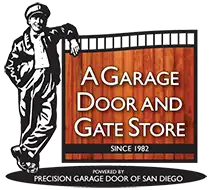7 Reasons Your Garage Door Is Stuck Open And How to Solve It
Like most homeowners, you probably use your garage door more than the front door of your home. According to a study, 45% of homeowners use the garage door as the main entrance into their home. This presents an issue if your garage door were to malfunction.

If your garage door isn’t opening or closing, there are many issues that could be going on. If it’s an emergency or presents an immediate danger to your home or family, call a repair technician. But if you’re able to assess the problem yourself, read on for reasons your garage door may not be opening.
The photo eye is out of alignment or dirty
Photo eyes are sensors placed on either side of a garage door to ensure that the door stops if anything gets in its way. An invisible beam connects the two photo eyes. If anything interrupts the beam, the sensor signals the system to break the circuit.
The sensor may break the circuit if the photo eye isn’t aligned or is dirty. In all these cases, the laser beam will get interrupted and cause the system to malfunction.

The most common issue is misalignment. If the photo eyes on opposite sides of the garage door become misaligned, the door won’t close.
When photo eyes malfunction, they may sense an object when there isn't one. If there’s dirt on the lenses, clean them with a soft cloth.
The track isn’t aligned
The track consists of two metal pieces on either side of the door, leading from the floor to the ceiling. The door operates by gliding along the tracks on a set of rollers.
When a track goes out of alignment, a gap develops between the rollers and the rail. When the problem is severe, the roller may come out of the track. It is also common for a misaligned track to bend or warp over time.
The most common cause for misaligned tracks is old age. It isn’t uncommon for a track to get out of alignment after operating thousands of times.
If the garage door isn’t aligned, you can perform adjustments to fix the door and avoid more damage.
A binding garage door happens when the door is impossible to operate. To fix a binding door, loosen the screws that secure the track to the door frame. Then, use a rubber mallet to reposition the track. Use a level to ensure the track is straight, then refasten the screws.
Fix a door that’s gapping or rubbing by moving the track. Loosen the top track and move it until there’s a quarter-inch gap between the door and molding. Tighten the track, then ensure it’s in place.
Broken torsion springs
Torsion springs are responsible for lifting the weight of the door. Most doors weigh between 150 to 250 pounds. Without working springs, the opener can’t lift the door.
Unfortunately, torsion springs don’t last forever. Most last about 10,000 cycles. Depending on how often you open the garage, that could be anywhere from six to 10 years. Most builders install low-cost doors and lower-cycle springs. The springs that builders install can last as little as three to five years.
There are a few ways to spot a spring problem:
- The opener is working but the door isn’t moving, or you may hear the opener straining to lift the door.
- You hear a loud pop like a firecracker. That was the sound of the torsion spring breaking.
- You may be able to see a split in the torsion spring.
If you have a broken spring, do not attempt to open the garage door. Attempting to lift a door with a broken spring is dangerous and can result in expensive problems.
Attempting to replace broken springs is even more dangerous. Only experienced professionals should ever touch torsion springs.
If there is only one broken spring, chances are the other will break soon. So, replace them both at the same time to avoid issues in the future.
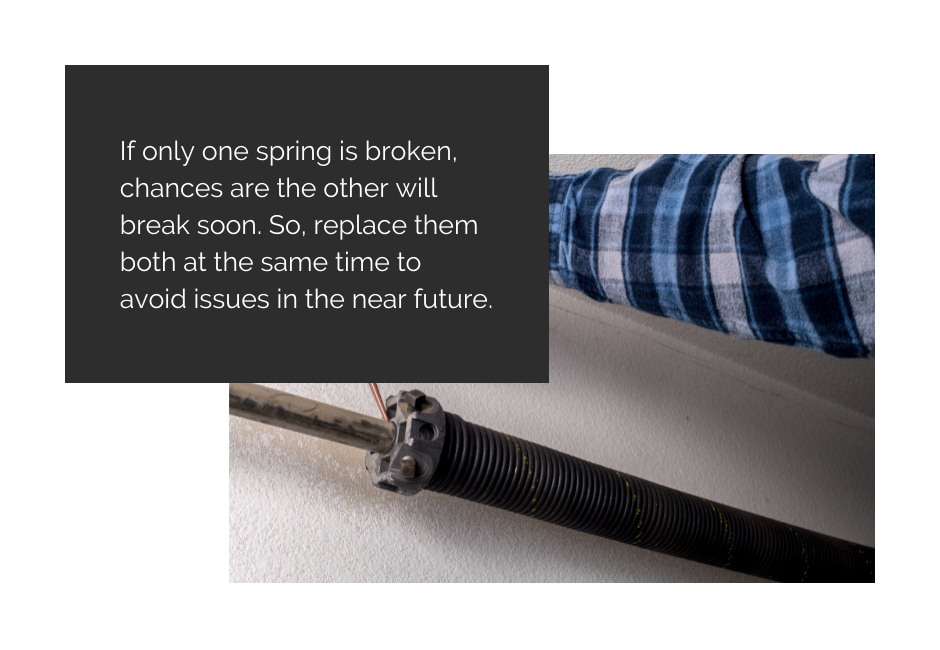
Stripped gear in the opener
The nylon gears inside of the garage door operator are prone to breakdown with age.
Here are some common signs of a stripped gear:
- If you press the remote and the operator makes a humming noise, but nothing happens.
- If you notice white plastic shavings on the floor or if you tap on the bottom of the motor and shavings fall out.
If you believe there is a stripped gear, open the operator and look inside. You should see a combination of white shavings and worn out teeth on the gear.
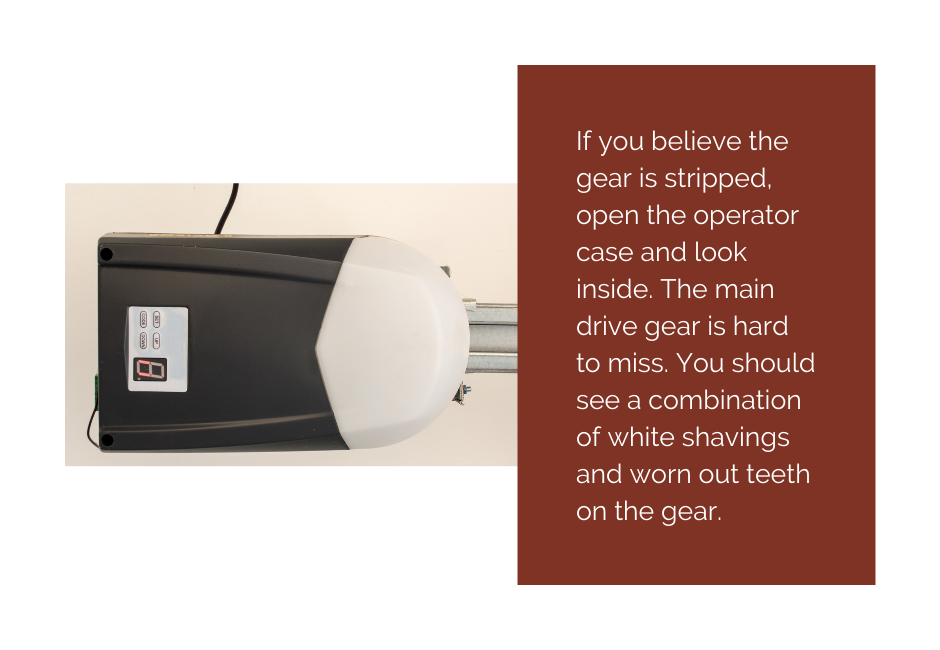
Gears are inexpensive and simple to replace. You can buy gears online and at local retailers. Most dealers sell supply kits with instructions. Changing the gear involves removing a few screws and sliding in the new gear. Make sure to grease the new gear. If you don’t, it may wear out in a matter of weeks.
Remote control malfunction
While a remote malfunction can be a headache, it’s one of the easiest problems to resolve.
The first likely issue is that the batteries are dead. Hold the remote next to the garage door motor. If it still does not work, then the battery is dead.
If the remote doesn't work when you press it, it may be experiencing RF interference. When this happens, the garage door doesn’t receive the remote’s signal. Often, motion detectors, alarm systems, and electronic game systems are behind this.
Sometimes a reset will reboot the circuit boards in both the remote and the receiver. To reset the remote, remove the batteries for 30 seconds and re-install them. To reset the receiver system, unplug the unit for a minute, then plug it back in. Then try using the remote again.
Sometimes the remote may need a reprogram. Check the user manual for instructions on how to reprogram it. To pair the remote, hold down the open button on the remote while pressing the programming button at the same time. Next, release the open button when the garage door opener light starts flashing.
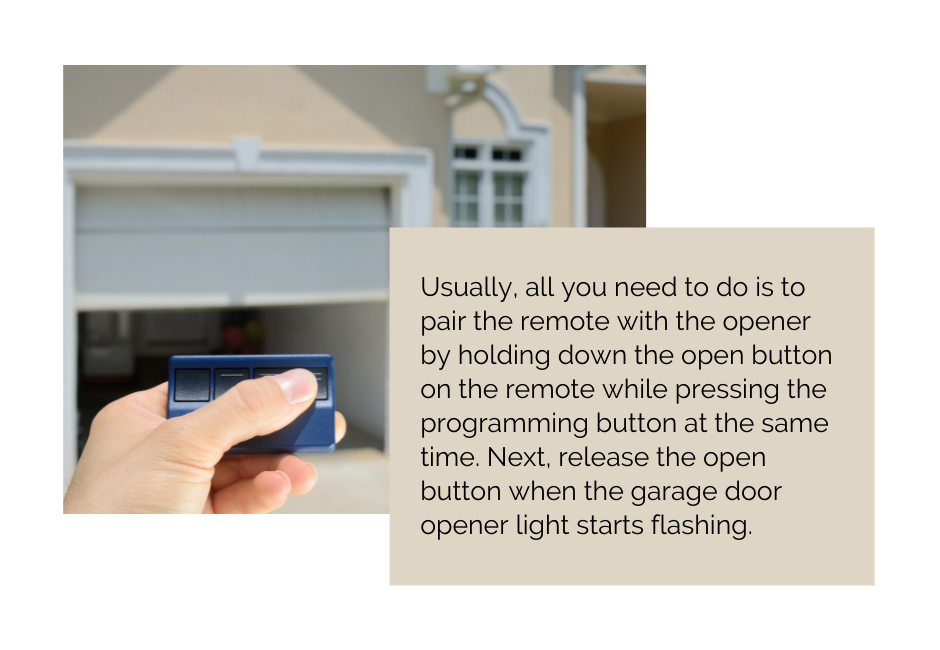
Allstar Remotes | Genie Remotes | Liftmaster Remotes | Linear Remotes
Loose or snapped cables
Automatic garage doors have cables on each side to lift and lower the door with ease. The cables transfer the energy from the torsion springs to the door. They’re constructed of aluminum or stainless steel. These cables are robust, but wear and tear can take its toll, causing the cables to lose tension, fray or snap.
First off, it’s important to note the cables are under an enormous amount of tension. If you don’t have the proper training, dealing with cables can be dangerous. If you notice that the garage door cables are loose or broken, call a technician to assess the situation.
There are four common causes of garage door cable problems:
- Incorrect drums and cables: Heavier doors require heavier cables. Using small cables with heavier doors can cause the cables to fray and snap sooner. Likewise, taller doors need longer cables and larger drums.
- The door hit an obstruction: Garage doors have photo eyes that keep them from closing on objects. If they’re faulty or if the door lacks these features, it may hit an obstruction while closing. Besides damaging the door, this can also cause a cable to come loose.
- Improper installation: During installation, springs are set at the right tension. Improper tension can cause the cables to jump off the drum if it's too strong or unwind if it's too weak.
- Busted torsion spring: Your garage door likely has one or two torsion springs. If one of these springs snaps, the cable will lose tension and come loose.

A broken cable causes the tension to transfer to the other cable, placing tremendous strain on it. This can make the garage door lift unevenly, causing it to become crooked and unbalanced. If the garage door is open, cut the unbroken cable to lower the door until a professional can take a look.
Stiff or off-track rollers
The rollers in your garage door consist of 10-12 wheels on a metal shaft that allow the door to open and close.
There are several types of garage door rollers:
- Plastic rollers are the lowest quality. They deliver adequate performance and last only a few years.
- Steel rollers last the longest, but their performance isn’t the best and they’re noisy.
- Nylon rollers are the quietest and offer the best performance. Depending on the quality, they can last 12 to 20 years.
Excessive wear causes the rollers to bind against themselves and the track. Move the door up and down and see if any rollers seem to bind. More often than not, it will occur when the roller is in the curved part of the track.
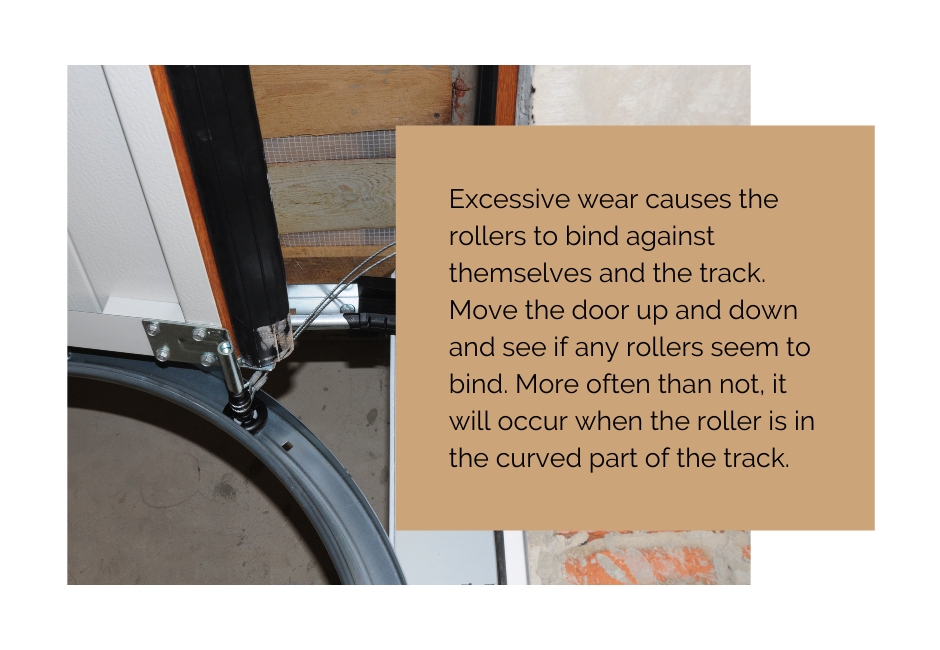
Rollers may also come off of the track. When the door is off-track, it may get stuck or sit at an angle. Common causes for rollers to come off the tracks include:
- Damaged tracks: Bent or damaged tracks can force rollers out of alignment. A dent or bend in the track can allow the rollers to come off.
- Loose tracks: The vibration of the door can loosen the bolts that hold the tracks in place. If the tracks are loose, the whole structure could become misaligned.
- Grime or debris: Built-up dirt and lack of lubrication can throw rollers off-track.
If the rollers have jumped the track, stop using the door until it’s repaired. Using the door when the rollers are off track can cause serious damage to the tracks or even the door itself.
Regularly assess the track to make sure it’s clear so the rollers can operate. In order for the rollers to run, you can also apply lubricant.
Before performing maintenance on the door, disengage the opener. This will allow you to distribute lubricant by sliding the door along the tracks.
To lubricate the rollers, always use a lithium- or silicone-based grease. When applying the lubrication, have a cloth handy to wipe up any drips. You may also want to put down a drop cloth or tarp to protect the floor from grease stains.
Lubricate rollers twice a year or sooner if they begin making noises while the door is in operation.
If you experience any of these issues, don’t attempt to force the door open or closed. Trying to force a door is dangerous and could bend the tracks, cause rollers to pop out and damage the system.
